Jharkhand Board JAC Class 9 Maths Solutions Chapter 12 Heron’s Formula Ex 12.2 Textbook Exercise Questions and Answers.
JAC Board Class 9th Maths Solutions Chapter 12 Heron’s Formula Ex 12.2
Page-206
Question 1.
A parks, in the shape of a quadrilateral ABCD has ∠C = 90°, AB = 9 m, BC = 12 m, CD = 5 m and AD = 8 m. How much area does it occupy?
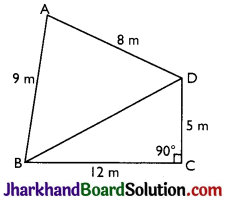
Answer:
∠C = 90°, AB = 9 m, BC = 12 m, CD = 5 m and AD = 8 m
BD is joined.
In ∆BCD,
By applying Pythagoras theorem,
BD2 = BC2 + CD2
⇒ BD2 = 122 + 52
⇒ BD2 = 169
⇒ BD2 = 169
⇒ BD = 13 m
Area of ΔBCD = 12 × 12 × 5 = 30 m2
Now,
Semi perimeter of ∆ABD
S = \(\frac{(8 + 9 + 13)}{2}\) m = \(\frac{30}{2}\) m = 15 m
Using Herons formula,
Area of ∆ABD = \(\sqrt{s(s-a)(s-b)(s-c)}\)
= \(\sqrt{15(15 -13)(15 – 9)(15 – 8)}\) m2
= \(\sqrt{l5x2x6x7 m2
= [latex]6 \sqrt{5}\) m2
= 35.5 m2 (approx.)
Area of quadrilateral ABCD = Area of ∆BCD + Area of ∆ABD
= 30 m2 +35.5 m2
= 65.5 m2
Question 2.
Find the area of a quadrilateral ABCD in which AB = 3 cm, BC = 4 cm, CD = 4 cm, DA = 5 cm and AC = 5 cm.
Answer:
AB = 3 cm, BC = 4 cm, CD = 4 cm, DA = 5 cm and AC = 5 cm
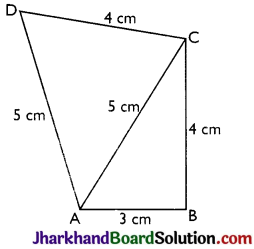
In ∆ABC,
Consider AC2 = 52 = 25
and AB2 + BC2 = 32 + 42 = 25
∴ AC2 = AB2 + BC2
Thus, ∆ABC is right angled at B.
Area of ∆ABC = \(\frac{1}{2}\) × 3 × 4 = 6 cm2
Now,
Semi perimeter of ∆ACD(s)
\(\frac{5+5+4}{2}\) cm = \(\frac{14}{2}\) cm = 7 cm
Using Herons formula,
Area of ∆ACD = \(\sqrt{s(s-a)(s-b)(s-c)}\)
= \(\sqrt{(7-5)(7-5)(7-4)}\) cm2
= \(\sqrt{7×2×2×3}\) cm2
= \(2 \sqrt{2}\) cm2
= 9.17 cm2 (approx.)
Area of quadrilateral ABCD
= Area of ∆ABC + Area of ∆ACD = 6 cm2 + 9.17 cm2 = 15.17 cm2
![]()
Question 3.
Radha made a picture of an aeroplane with coloured paper as shown in Fig. Find the total area of the paper used.
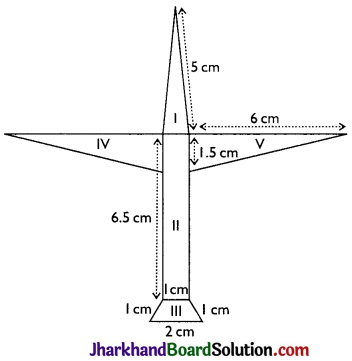
Answer:
Length of the sides of the triangle section I = 5 cm, 1 cm and 5 cm
Perimeter of the triangle = 5 + 5 + 1 = 11 cm
Semi perimeter = \(\frac{11}{2}\) cm = 5.5 cm
Using Heron’s formula,
Area of section I = \(\sqrt{s(s-a)(s-b)(s-c)}\)
= \(\sqrt{15.5(5.5 – 5)(5.5 – 5)(5.5 – 1)}\) cm2
= \(\sqrt{5.5 × 0.5 × 0.5 × 4.5}\) cm2
= \(0.75 \sqrt{11}\) cm2
= 0.75 × 3.317 cm2
= 2.488 cm2 (approx.)
Length of the sides of the rectangle of section II = 6.5 cm and 1 cm
Area of section II = 6.5 × 1 cm2 = 6.5 cm2
Area of section III
Draw BE || AD such that ABED is a parallelogram (as AB || DE and AD || BE)
Also, draw BF ⊥ EC
Now, DE = AB = 1 cm and AD = BE = 1 cm (Opposite sides of parallelogram)
⇒ EC = DC – DE = 2 – 1 = 1 cm
⇒ BE = BC = EC = 1 cm
⇒ ∆BEC is an equilateral triangle.
∴ F is the mid point of EC.
⇒ EC = FC = \(\frac{1}{2}\) cm.
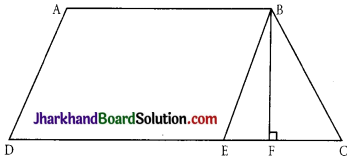
In ∆BFC, right angled at F
BC2 = BF2 + CF2
12 = BF2 + (\(\frac{1}{2}\))2
BF2 = 1 – \(\frac{1}{4}\) = \(\frac{3}{4}\)
⇒ BF = \(\frac{\sqrt{3}}{2}\) cm
So, Area of trapezium = \(\frac{1}{2}\) (sum of parallel sides) × height
= \(\frac{1}{2}\) (AB + CD) × BF
= \(\frac{1}{2}\) (1 + 2) \(\frac{\sqrt{3}}{2}\)
= \(\frac{3 \sqrt{3}}{4}\)
= 1.3 cm2
Section IV and V are 2 congruent right angled triangles with base 6 cm and height 1.5 cm
Area of region IV and V = 2 × \(\frac{1}{2}\) × 6 × 1.5 cm2 = 9 cm2
Total area of the paper used = (2.488 + 6.5 + 1.3 + 9) cm2 = 19.3 cm2
![]()
Question 4.
A triangle and a parallelogram have the same base and the same area. If the sides of the triangle are 26 cm, 28 cm and 30 cm, and the parallelogram stands on the base 28 cm, find the height of the parallelogram.
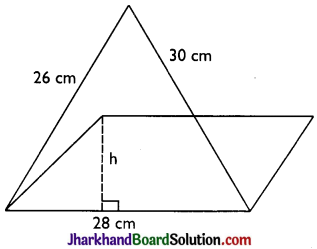
Answer:
Given,
Area of the parallelogram and triangle are equal.
Length of the sides of the triangle are 26 cm, 28 cm and 30 cm.
Perimeter of the triangle = 26 + 28 + 30 = 84 cm
Semi perimeter of the triangle 84
s = \(\frac{84}{2}\) cm = 42 cm
Using Heron’s formula,
Area of the triangle
= \(\sqrt{s(s-a)(s-b)(s-c)}\)
= \(\sqrt{42(42-26)(42-28)(42-30)}\)
= \(\sqrt{42×16×14×12}\) cm2 = 336 cm2
Let height of parallelogram be h cm.
Area of parallelogram = Area of triangle
⇒ 28 × h = 336
⇒ h = \(\frac{336}{28}\) cm
⇒ h = 12 cm
The height of the parallelogram is 12 cm.
Page-207
Question 5.
A rhombus shaped field has green grass for 18 cows to graze. If each side of the rhombus is 30 m and its longer diagonal is 48 m, how much area of grass field will each cow be getting?
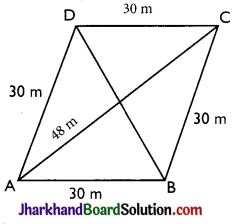
Answer:
Diagonal AC divides the rhombus ABCD into two congruent triangles of equal area.
Semi perimeter of ∆ABC = \(\frac{(30 + 30 + 48)}{2}\) m = 54 m
Using Herons formula,
Area of the ∆ABC
= \(\sqrt{s(s-a)(s-b)(s-c)}\)
= \(\sqrt{54(54-30)(54-30)(54-48)}\) m2
= \(\sqrt{54×24×24×6}\) m2
= 432 m2
Area of field = 2 × area of the ∆ABC
= (2 × 432) m2 = 864 m2
Thus,
Area of grass field which each cow will be getting = \(\frac{864}{18}\) m2 = 48 m2
Question 6.
An umbrella is made by stitching 10 triangular pieces of cloth of two different colours (see Fig.), each piece measuring 20 cm, 50 cm and 50 cm. How much cloth of each colour is required for the umbrella?
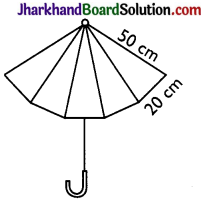
Answer:
Semi perimeter of each triangular piece
\(\frac{(50 + 50 + 20)}{2}\) cm
= \(\frac{120}{2}\) cm = 60 cm
Using Herons formula,
area of the triangular pieces of each colour
= \(\sqrt{s(s-a)(s-b)(s-c)}\)
= \(\sqrt{60(60 – 50)(60 – 50)(60 -20)}\) cm2
= \(\sqrt{60×10×10×40}\) cm2
= \(200 \sqrt{6}\) cm2
Area of 5 triangular pieces = 5 × \(200 \sqrt{6}\) cm2
= \(1000 \sqrt{6}\) cm2
Hence, cloth require for each colour = \(1000 \sqrt{6}\) cm2
![]()
Question 7.
A kite in the shape of a square with a diagonal 32 cm and an isosceles triangle of base 8 cm and sides 6 cm each is to be made of three different shades as shown in Fig. How much paper of each shade has been used in it?

Answer:
We know that,
As the diagonals of a square bisect each other at right angle.
Area of square = \(\frac{1}{2}\) (diagonal)2
= \(\frac{1}{2}\) x 32 x 32 = 512 cm2
Area of shade I = \(\frac{1}{2}\) cm2
= 256 cm2 = Area of shade II
So, area of paper required in each of shade
I and shade II = 256 cm2 For the III section,
Length of the sides of triangle are 6 cm, 6 cm and 8 cm Semi perimeter of triangle (6 + 6 + 8)
s = cm = 10 cm
Using Herons formula,
Area of section III = \(\sqrt{s(s-a)(s-b)(s-c)}\)
=\(\sqrt{10(10 – 6)(10 – 6)(10 – 8)}\) cm2
= \(\sqrt{10×4×4×2}\) cm2 = \(8 \sqrt{5}\) cm2
= 17.92 cm2
Hence paper needed for shade I = shade
II = 256 cm2 paper needed for shade
III = 17.92 cm2
Question 8.
A floral design on a floor is made up of 16 tiles which are triangular, the sides of the triangle being 9 cm, 28 cm and 35 cm (see Fig.). Find the cost of polishing the tiles at the rate of 50p per cm2.
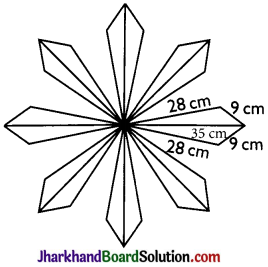
Answer:
Semi perimeter of the each triangular shape = \(\frac{(28 + 9 + 35)}{2}\) cm = 36 cm
Using Herons formula,
Area of the each triangular shape
= \(\sqrt{s(s-a)(s-b)(s-c)}\)
= \(\sqrt{36(36 – 28)(36 – 9)(36 – 35)}\) cm2
= \(\sqrt{36×8×27×1}\) cm2 = \(36 \sqrt{6}\) cm2
= 88.2 cm2
Total area of 16 tiles
= 16 × 88.2 cm2= 1411.2 cm2
Cost of polishing tiles = 50 p per cm2
Total cost of polishing the tiles = ₹ (1411.2 × 0.5) = ₹ 705.6
![]()
Question 9.
A field is in the shape of a trapezium whose parallel sides are 25 m and 10 m. The non-parallel sides are 14 m and 13 m. Find the area of the field.

Answer:
Let ABCD be the given trapezium with parallel sides AB = 25 m and CD = 10 m and the non-parallel sides AD = 13 m and BC = 14 m.
Draw CM ⊥ AB and CE || AD.
In ∆BCE,
BC = 14 m, CE = AD = 13 m and BE = AB – AE = 25 – 10= 15 m
Semi perimeter of the ∆BCE = \(\frac{(15 + 13 + 14)}{2}\) cm = 21 cm
Using Heron’s ormula,
Area of the ∆BCF = \(\sqrt{s(s-a)(s-b)(s-c)}\)
= \(\sqrt{21(21 – 14)(36 – 13)(21 – 15)}\) m2
= \(\sqrt{21×7×8×6}\) m2
= 84 m2
Area of the ∆BCE = \(\frac{1}{2}\) × BE × CM = 84 m2
⇒ \(\frac{1}{2}\) × 15 × CM = 84
⇒ CM = \(\frac{168}{15}\) m
⇒ CM = \(\frac{56}{5}\) m
Area of the parallelogram AECD = Base × Altitude = AE × CM
= 10 × \(\frac{56}{5}\) = 112 m2
Area of the trapezium ABCD
= Area of AECD + Area of ∆BCE = (112 + 84) m2= 196 m2